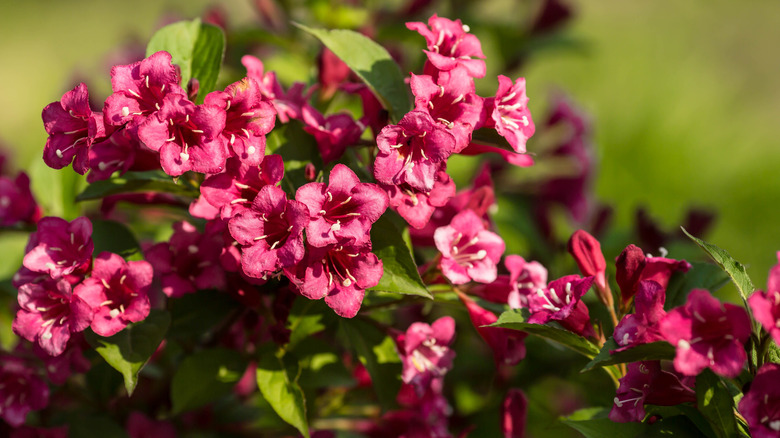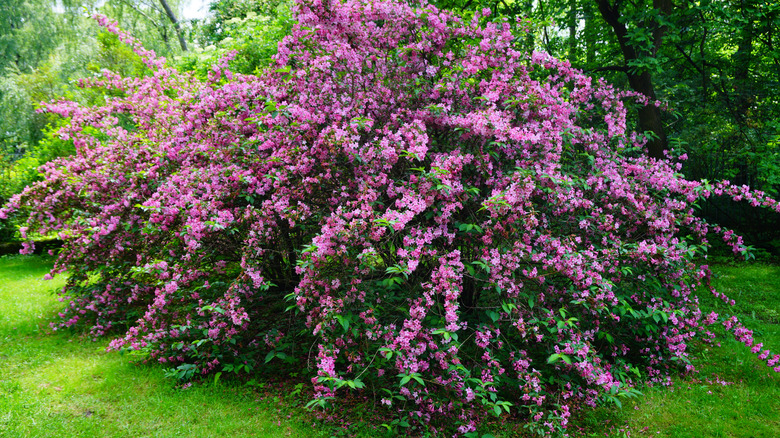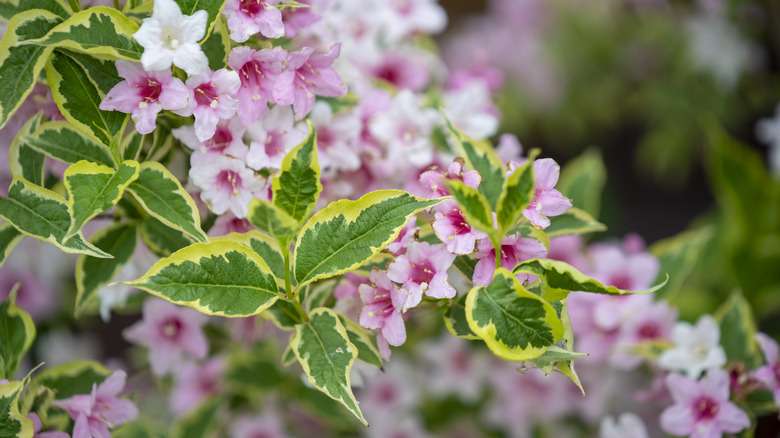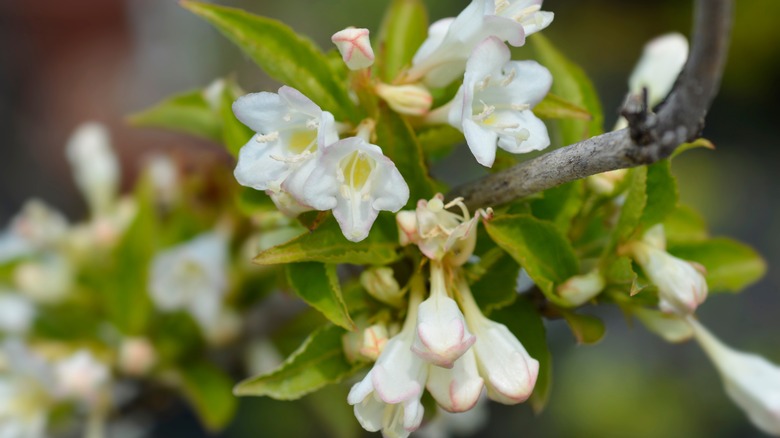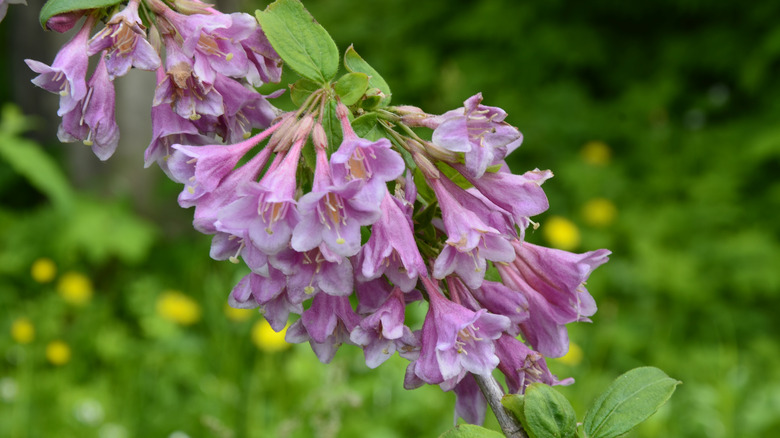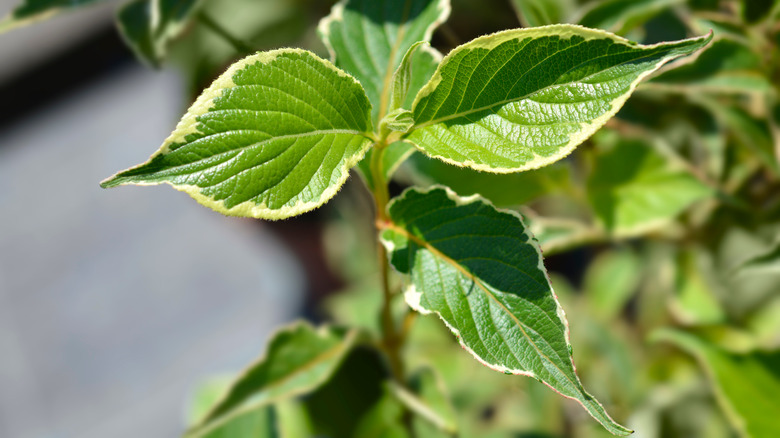Weigela: Everything You Should Know Before Planting
Weigela, a genus of deciduous flowering shrubs, is a popular, non-toxic garden plant. There are currently 13 accepted species of weigela and many more that are in review, according to The Plant List, with some of the most well-known species including weigela florida and weigela japonica. All plants within this genus can be recognized by their white, pink, red, or yellow tubular-shaped flowers and oblong leaves, but weigelas' growth habits can differ between species. For example, some grow upright while others will arch or mound, says Garden Design.
Weigela is known as a romantic plant. It has been around for many centuries, as it was first imported to Europe in the 1800s but grown in its native regions of Asia for many years before that. Since being imported, botanists have taken it upon themselves to create several new species and varieties of the shrub that boast colorful flowers and uniquely patterned leaves. Today, weigela is a relatively low-maintenance plant, though it does need full-sun locations and some pruning.
How to use weigela in the garden
Weigela is meant for the garden. Most species within the genus are great for planting as border plants, in bedding displays, or even as hedging if you find yourself a larger variety. This plant can range in height from 10 feet tall and 12 feet wide to 12 inches tall and 18 inches wide, depending on the type you purchase, as per Garden Design. It's important to remember when you are buying weigela plants to find information about how tall and wide they will grow. You wouldn't want to buy a 10-foot-tall shrub to plant in a container to keep on your porch.
HGTV suggests landscaping with weigela by choosing brightly colored varieties that draw the eye. While some cultivars have showy flowers, others have variegated leaves in lime green and chartreuse shades. You can use this to your advantage, lining a path with weigela to lead people through your garden. Alternatively, you can use low-growing species of the plant to cover large sections of the ground. They'll give more texture and color to sloping hills or darker parts of your lawn.
How to grow weigela
Luckily, growing weigela isn't too complicated. You can easily find your favorite cultivar at your local nursery or propagate with cuttings from a mature plant you already own. All you need to start with propagation is sterile shears, a propagation tray or a small pot, rooting hormone, and a well-draining rooting medium, as Mike Kincaid explains on his YouTube channel.
Before taking your cuttings, make sure that your mature weigela plant is hydrated. This will help both your cuttings and the existing plants. When you're ready to start the propagation process, cut off as many stems as you need below a node and ensure that each cutting has at least two leaves on it. Cut the tips off these leaves to reduce moisture loss. Then, dip the end of your stem into a rooting hormone before planting it into your pot or propagation tray filled with soil. Put the lid on your tray or wrap plastic around your pot to lock in as much humidity as possible to help your cuttings grow.
Make sure to place them in an indirectly sunny spot, so you don't accidentally cook the young plants. In about three weeks, the propagated weigela will begin forming roots. When eight to 10 weeks pass, you can start slowly introducing the cuttings to fresh air and some sunlight. Once they are acclimated, it's time to grow them as normal and enjoy your new weigela plants.
How to care for weigela
According to Garden Frontier, caring for weigela plants isn't difficult, especially when they are grown outside in full sun with well-draining moist soil. Once established, they won't need watering unless your area is experiencing very hot and dry weather. The plants can grow in various conditions as most cultivars are hardy to USDA zones 4 through 8. Though plenty of sunlight is best for them, they can still grow in partial shade. However, remember that they will not bloom as beautifully if you don't meet their care requirements.
Regular pruning is a necessary part of care if you want to keep this shrub healthy. Hawks Landscape recommends pruning in the spring and occasionally in the summer if your plant shows vigorous growth. You should begin the process as soon as your weigela bush blooms during mid to late spring. Make sure you do not prune more than 1/3 of the growth of the top. Remember that you are pruning to reduce the size and improve the shape of the weigela, so go slow and take a look at your work regularly if you are new to this practice.
Additionally, weigela can benefit from some fertilization during its growing season. You may use granular or stake fertilizer once per year by working it into the soil throughout the garden bed. Moreover, you could feed it some liquid fertilizer by mixing it with water three or four times per year.
Weigela varieties
With thirteen confirmed species and many more varieties of weigela, this plant has countless versions to choose from. This shrub, with all species native to Asia, is well-known for its brilliantly colored flowers and gorgeous variegation on some varieties' leaves. However, because there are so many types of weigela, the most beautiful of them stand out, and the most popular cultivars come from the florida species. As told by Better Homes & Gardens, here are some of the best and brightest weigela florida cultivars.
- Weigela Red Prince — This is a red blooming weigela with a large growth habit, often growing as large as 6 feet wide and 5 feet tall.
- Weigela Ghost — This variety is named for its ghastly pale yellow-green foliage. The shrub also produces red flowers and can become 5 feet tall.
- Weigela Polka — This plant shows off light pink flowers for a long blooming period, from summer to fall. The blooms are made even more noticeable by the plant's darkly colored green-blue leaves.
- Weigela Verweig — This is a compact type of weigela, only growing to a height of about 18 inches. It has variegated green and white leaves with small pink blooms.
- Weigela Briant Rubidor — This plant has glossy variegated leaves that support reddish-pink flowers. The variety grows up to 7 feet tall, so it is used as hedging on some landscapes.
How to repot weigela
Though weigela can be technically repotted, more often than not, it is transplanted. This is because most weigela species are too large to keep in a pot, and even the smaller variations look better in the garden. Therefore, the shrub will likely be large when you purchase it from your local nursery as many of them are sold in 5-gallon pots meant to be planted in your garden. To transplant yours, you'll need to do a little preparation that we can help you with.
As per SFGate, once you have picked the perfect spot in your yard for a weigela bush, you can begin the transplanting process by digging an area about 10 inches deep and a few feet in diameter. Overall, it's best to dig the hole in the new location to be the same size as your plant's rootball. Don't remove any of the dirt from the hole just yet. Instead, add some compost to your soil to supplement it with nutrients and work it into the existing soil. Next, remove your weigela plant from its pot or the garden plot where you originally planted it.
For the best results, you should water your weigela 24 hours before the transplant to avoid shock. And once your shrub is in the chosen spot, cover its roots with soil and pack it around the base of its stems. After this, you may also set mulch atop the soil to help the weigela establish itself.
